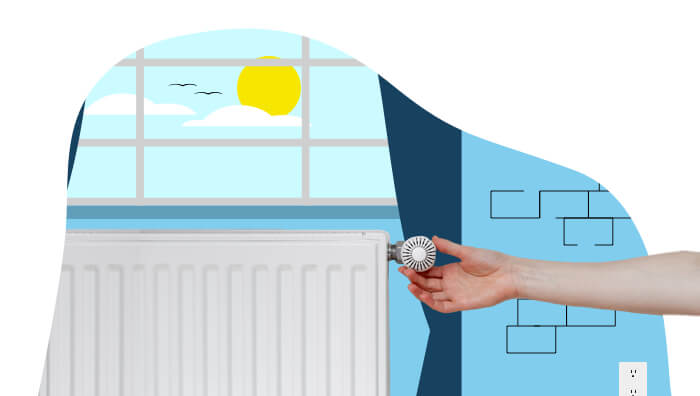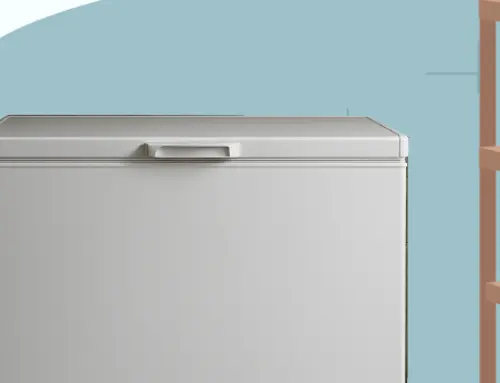How to Tell If Your Heat is Gas or Electric (Step by Step Guide)
by Tyler Castle
6.6 min read

When moving to a new home, getting utilities up and running is a top priority. However, before contacting service providers, it’s important to identify if your heat is gas or electric.
If you’ve been wondering, What heating system do I have? Or, Does my heater use gas or electricity? We’ve created a guide to help you answer these burning questions.
Read on to discover how you can learn everything you need to know about your home’s heating system to determine the services you need, save time and money, and how to properly maintain your equipment.
How to tell what kind of heating system you have
Heating systems explained: Is my heater gas or electric?
How to tell what kind of heating system you have
The first step in learning how to tell if heating is gas or electric is to identify what type of system you have in your home. Unsure of what kind of heater you have? Here are the most common heating systems and how they work.
Furnaces
Furnaces are one of the most popular heating mechanisms. They use a central unit to generate heat, then distribute it throughout a residential or commercial space via vents or ductwork.
Furnaces can be powered by electricity, gas, propane, or oil. They come in different sizes and vary in efficiency, with modern options offering energy-saving features like variable-speed blowers and modulating gas valves. Furnaces are typically in out-of-way areas such as basements, attics, closets, or crawl spaces. If you’re unsure whether your furnace runs on gas or electricity, locating the one in your home is the first step in understanding how it works.
Boilers
Boilers use water or other fluids to generate heat. They bring the fluids to a high temperature and circulate the resulting steam through radiators or pipes to warm rooms or spaces. Like furnaces, boilers can be powered by various sources, including gas, electricity, or oil. However, they are different in that they directly warm surfaces in their vicinity, like baseboards or floor panels, instead of distributing heat through a vent or duct.
Boilers can often be confused for water heaters. However, they serve different functions:
|
Boiler
|
Water Heater
|
However, there are combination units that, in addition to providing heat, can supply homes with hot water, making them a versatile and efficient heat source for those who have them.
Heat pumps
Heat pumps extract heat from one location and transfer it to another. They consist of two components, one located indoors and the other outside. Unlike other heating systems that directly generate heat, heat pumps absorb heat from natural sources like outdoor air, water, or the ground and transfer the thermal energy inside.
Heat pumps are energy efficient because they transfer heat rather than generate it. Plus, they’re versatile in that they offer cooling functions too. The cooling process works in reverse by extracting heat indoors and releasing it outside. Most common in places with moderate climates, heat pumps run on geothermal power or electricity. They can be expensive to install but offer many long-term benefits as they are energy-efficient, quiet, and don’t burn fossil fuels making them environmentally friendly.
Radiant floor heat
This heating system generates heat through hot water pipes or electric resistance cables installed underneath the surface of the floor. As heat from these sources moves upward, it warms the space above it.
Radiant floor heating creates even heat distribution and eliminates the need for radiators, baseboard heaters, and other traditional mechanisms. There are three main types of radiant floor heat, all of which offer advantages like reduced allergens, increased energy efficiency, and relatively silent functionality.
Baseboard heaters
Typically located along the baseboard of a wall, this heating system consists of a hot water pipe or long and narrow heating element encased in a metal housing. This simple solution heats air near the floor, which rises and circulates throughout a room to warm the space.
Baseboard heaters can be controlled by thermostats and are known for being a cost-effective way to provide localized heating in desired rooms.
Heating systems explained: Is my heater gas or electric?
The best way to determine if your heating system is gas or electric is to look for visual clues. Reading the label, checking for a burner, pilot light, gas line, or exhaust vent, and listening for a gas burner can all indicate how your system is powered.
Here’s a detailed look at how to tell if your heater is gas or electric.
1. Read the label
Head to your heating system and see if there is any indication of the power source. The label may mention if it runs on natural gas, propane, oil, or electricity. If not, try searching for the name and model of your heater online.
2. Check for a burner or pilot light
Gas heaters generally have a visual burner or pilot light serving as an ignition source for the gas burner. If your furnace has a small window with a glowing blue flame, this is your pilot light and hint that it’s gas-powered. Electric furnaces will not have this window.
3. Find the gas line
Depending on the type of furnace or heating system, you may see a black iron, copper, steel, or plastic pipe connected to your gas line. Listen carefully too. If you hear a low hum or consistent sound, it probably means your heating system is powered by gas. Electric furnaces don’t make noise while idle.
4. Look for an exhaust vent
Do you see an exhaust vent? If not, it likely means your system is electric.
While most heaters use gas or electricity, yours may be fueled by an alternative source like oil, solar power, or geothermal energy. If you can’t determine how your heating system works based on the visual clues, don’t hesitate to contact a professional. Experts at reputable energy service companies like Santanna can help you properly identify how your home is heated.
What’s next?
Once you’ve determined whether your heater operates on electricity or gas, you can set up the correct utilities and or replace your system with a different one.
Finding the right service provider
Heating your home can be expensive, making up about a third of a utility bill. Finding the right energy provider is key to livingly comfortably and knowing your equipment works properly.
If you’re looking for a customer-driven provider that offers innovative and earth-friendly energy solutions, check to see if Santanna serves your area.
Replacing existing heating systems
Check out your heating system to see if it’s running properly or needs to be replaced. It may be old, or you might want to replace your current heater with a preferred one. Now that you’re familiar with the different systems, you may opt for a more earth-friendly system or choose to switch from gas or electric or vice versa.
Once you know if your heat is gas or electric, you can select the right utility services, find the right service provider, perform proper maintenance and repairs, and make informed decisions regarding energy efficiency and safety measures.
Santanna Energy Services is a supplier of renewable energy solutions in the United States, providing services to Illinois, Indiana, Pennsylvania, Michigan, and Ohio. We provide a wide range of energy services and products to meet the needs of both residential and small business customers. Our mission is to provide innovative and cost-effective energy solutions that will help our customers achieve their energy goals. With over 35 years of experience, we are committed to creating life-long relationships by providing quality service to customers, communities, and employees. To learn more, check out Santanna’s energy plans.
Tyler is an experienced energy professional, having worked for Santanna Energy Services, for the past four years. He is passionate about renewable energy and believes that diversifying the energy grid is the key to a sustainable future. Tyler is dedicated to supplying consumers with the best possible energy solutions and works diligently to make sure that Santanna can deliver the highest quality service.







